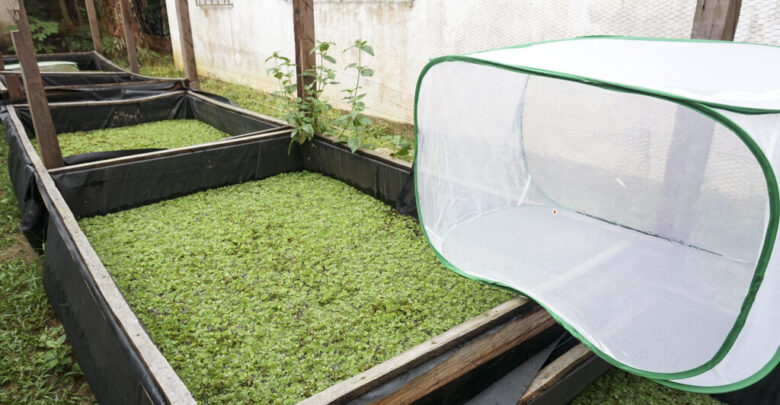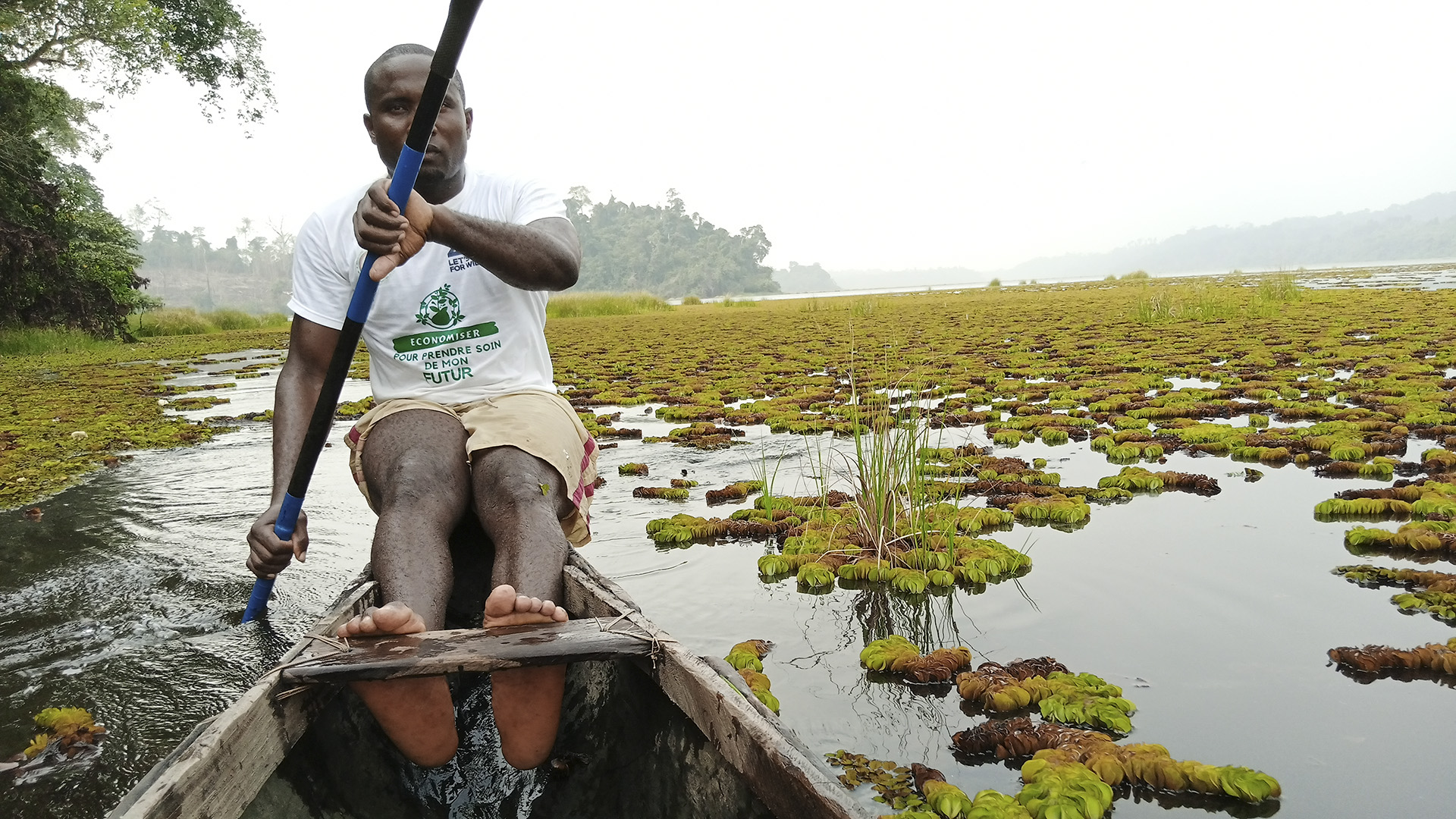

DIZANGUÉ, Cameroon — Scientists are preparing to deploy an army of over 6,000 water-dwelling beetles to clear an invasive water weed choking Cameroon’s Lake Ossa.
The black, subaquatic insects measuring 2-3.5-millimeter-long, called salvinia weevil, have been mass-reared for release into the lake.
Scientists experimentally released some weevils in a semi-confined lake area on July 27.
“The weevils were brought in from the Louisiana State University in the United States with the authorization of the Cameroon government,” Aristide Takoukam Kamla, founder of the African Marine Mammal Conservation Organization in Cameroon, told Zenger News.
The invasive weed, called salvinia molesta, has invaded nearly 70 percent of the lake’s 4,000-hectare surface.

The weed is a floating aquatic fern that thrives in slow-moving, nutrient-rich, warm freshwater. It first appeared in the lake in 2016 and regenerates within ten days, thereby decimating the lake’s ecosystem.
But the tiny weed-eating beetles could restore the lake to its former state.
“The weevil [both adults and larvae] feed on the growing buds of the floating salvinia fern,” Matthew Purcell, director of the Australian Biological Control Laboratory, told Zenger News.
The United States Department of Agriculture and the Commonwealth Scientific and Industrial Research Organisation run the facility.
“They are effective because when the bud is damaged, it will most likely cause the remainder of the plant to die and sink. It is very damaging and effective.”
The weevil feeds exclusively on the salvinia plant and will die without their host, according to scientists. This method — known as biological control — successfully suppresses invasive plant populations and restores water bodies to ecological balance.
Although native to south-eastern Brazil and northern Argentina, salvinia molesta has spread widely throughout the world during the past 50 years, choking lakes, rivers, and even rice paddies.
However, human activities fueled its spread in Cameroon.

“The nutrients [they feed on] could be coming from the industries, plantations, and hydroelectric dam reservoirs constructed upstream,” Kamla said.
“Two main nutrients needed for invasive weeds to grow are nitrogen and phosphorous coming from upstream. A 3-kilometer [1.8-mile] channel connects Lake Ossa and the Sanaga River [the largest river in Cameroon]. Once this river gets polluted, the lake also gets polluted.”
Kenfack Voukeng Sonia Nadège, a weed scientist at Green Connexion, a local environmental conservation non-governmental organization, points to similar human factors.
“Houses built without proper flushing systems contribute to the increase of the nutrients in the environment,” she told Zenger News.
“Pollution due to human activities favor the development of these water weeds.”
Before the weed takeover, the lake was replete with freshwater turtles, crocodiles, more than 18 families of fish, monitor lizards, snakes, aquatic birds, and the rare African manatee.
These aquatic species are now fast disappearing as a result of the presence of the water weed.

“The covers [of aquatic weeds] indirectly deplete dissolved oxygen, thereby, suffocating and killing native fish and phytoplankton,” Kenfack told Zenger News.
“As floating weeds, they form dense covers on the surface of water bodies, disrupting aquatic flora and fauna underneath and thus adversely affecting the water ecosystem. This hinders water flow, fishing, swimming, boating, water sports, and navigation.”
Roland Ngolle, 36, who has fished in Lake Ossa for 12 years, said the lake is losing its depth owing to the weed.
“Some portions of the lake that were three meters deep are barely a meter deep now,” he told Zenger News.
“Initially, we thought that fish were hiding beneath the weed. But we notice they are instead leaving. More than 100 fishermen used to fish in this lake every morning, but today less than five people come out to the lake each morning.”
Over 80 percent of the riparian communities used to depend on fishing for livelihoods, according to the environmental group Global Water Partnership, but have lost a similar percentage of their income.

Women retailers who depend on the fish from the lake share stories of hardship due to the dwindling fish catch from the lake.
“We are pleading with the government to assist us,” said 57-year-old Dora Sih, a mother of 12 who has been selling fish caught from the lake for the past 25 years.
“We are suffering. Things are not moving. With reduced fish supply, feeding my family is proving difficult.”
With reduced fish supply, human nutrition in riverine communities, where fish is the primary source of protein, is jeopardized, leading to poor health, according to Kenfack.
Since its first release at Lake Moondarra, Australia, in 1980, the salvinia weevil has been used to control the weed in several Asian, Pacific, and African countries.
“Lake Moondarra is mostly clear of salvinia today,” Purcell told Zenger News.

“The weevil population follows the growth of the weed closely. In spring and summer, salvinia increases, and in turn, the weevils breed and build up populations that reduce [kill] the salvinia. The weevils only feed on the weed and will die without their host. They pose absolutely no risk to the ecosystem, only improving it by returning it to a more natural state.”
The KIT Royal Tropical Institute‘s former staff member, Arnold Pieterse, said the weevils effectively rid Senegal River of the invasive weed.
“We [first grew] a starter population in small basins and subsequently released the weevils on salvinia plants in the river,” he told Zenger News.
“It has irrefutably been proven that the insects do not form any danger to the environment or crops.”
He has coordinated tropical ecology and weed control projects in various parts of the world, mainly in Africa.

Thanks to biological control, South Africa recorded similar success in controlling the weed in Mpumalanga, KwaZulu-Natal, Western Cape, and Eastern Cape provinces.
“Following its release, the weevil rapidly controlled salvinia molesta infestations throughout its invaded range,” Julie Coetzee, deputy director, and manager of the Aquatic Weed Biocontrol Program at Rhodes University, South Africa, told Zenger News.
“We still do get some new infestations appearing, and once weevils are released, we typically get clearing with a season.”
Though scientists consider the biological method more effective than manual removal or chemical control, scientists are cautious.
“The effectiveness varies from site to site depending on environmental parameters, temperature, nutrient availability and water flow, shade, etc.,” Purcell told Zenger News.
“Some salvinia must be tolerated, as this sustains a population of the weevil, and complete eradication never occurs.”
Because the weevils have successfully been used in Africa to control this weed, prospects in Cameroon are excellent, Purcell said.
“Most control is achieved within three years.”
(The GLF-Climate Tracker Drylands Fellowship supported this report.)
(Edited by Kipchumba Some and Anindita Ghosh)
The post Beetles To The Battle: Scientists Deploy An Army Of Tiny Insects To Restore Cameroon’s Dying Lake appeared first on Zenger News.





